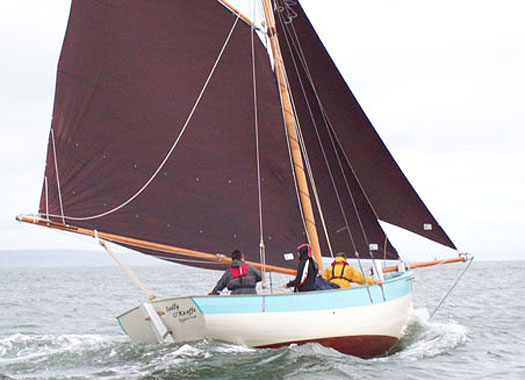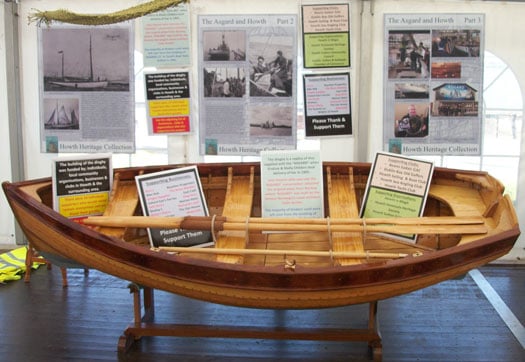Displaying items by tag: West Clare
#woodenboat – The wonderful world of Ireland's wooden boats is a winding trail. W M Nixon went to West Clare to see one boat, but unexpectedly happened upon another with which he was totally smitten. Then he found the original objective of his travels was even better than expected. And finally back home, he found the project to re-create Asgard's 10ft dinghy from 1905 has produced a gem of classic boat-building.
With Sally O'Keeffe, it's love at first sight. I defy anyone to resist the allure of this shapely beauty.
You may have heard of this community project in southwest Clare, to build a replica of the working cutters which used to ply their trade in the demanding waters of the Shannon Estuary. And like me, you may even have noted with pleasure that the designer to the project was Myles Stapleton of Malahide, the great unsung star of Irish naval architecture, who has never drawn an unharmonious line in his life.
Yet like me, while you may have been aware that the boat was first launched in 2012, somehow neither of us has ever been in the presence of this remarkable little ship. And this despite the fact that she has been cutting a swathe through the fleet at classic and traditional events between Galway Bay and Baltimore for the past year and more.
Even with all this, I was actually trying to find the whereabouts of another new wooden boat entirely when I stumbled upon Sally O'Keeffe - newly-launched in Kilrush last Saturday - and was instantly smitten. For she's only gorgeous. She looks so utterly right, she's mad keen to sail which she does very well indeed, and she brings much pleasure to everyone involved. This has to be the community project par excellence. But then, Querrin in West Clare is a genuine community par excellence, an idea and vision as much as a place.
It's spread out on your left down towards the Shannon Estuary as you enter the Loop Peninsula, which is Ireland's ultimate place apart. Loop Head's island atmosphere is very marked, with the extensive but shallow Poulnasherry Bay west of Kilrush pushing northwest deep into the land, almost to Kilkee. Thus places like Querrin, until well into the 19th Century and even later, were much reliant on goods being landed at and exported from their little quays.
The Shannon Estuary is a mighty highway, but with the biggest tides in Ireland – 5.6 metres range at top of springs – the workboats carrying the vital goods had to be multi-functional and capable of taking aboard diverse cargoes. Not least of the requirements was a good all-round sailing ability, for although the Galway Hookers away to the north largely plied their trade by reaching back and forth across Galway Bay from Connemara to the Aran Islands, the Shannon Hookers had to excel in windward ability in order to sneak along inside the inevitable foul tides, and weather the increasingly difficult headlands which they encountered as they made their way west. Thus the boats which regularly sailed to Querrin were among the most able on the estuary, and long after the last of them sailed, the folk memory of their significance lingers on.
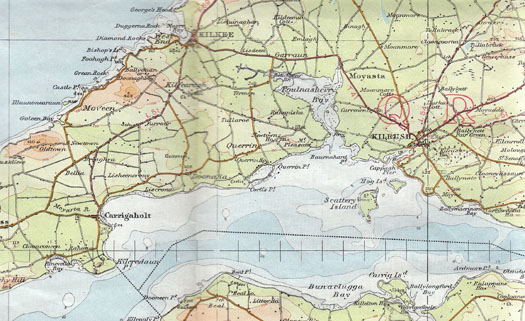
Querrin at the heart of things. Once you get west of Poulnasherry Bay, you're in the remote island-like atmosphere of the Loop Head Peninsula. Loop Head itself is another six miles west of the left edge of this map

Sally O'Keeffe provided a formidable design challenge for Myles Stapleton, as he had to create a roomy and high freeboard hull which still managed to incorporate elegant curves, yet all within an overall hull length of only 25ft. And of course, she had to sail very well too. Photo: W M Nixon
It was thought that the ribs of one of the old sailing workboats were sticking out of the mud at Blackwater Bridge on the road approaching Querrin from Moyasta. So as a local Querrin Sailing group began to gain traction, they got the notion of getting those last remains out of the mud, and restoring a proper Shannon Hooker to be the flagship of their little fleet, and the focus of a worthwhile community project in boat-building.
Perhaps it's as well the old wreck proved to be no more than shallow-water cot, for this seeming disappointment led eventually to designer Myles Stapleton and a magnificent but manageable project to build a new 25ft Shannon Hooker, using ancient photos and old drawings to re-create the best of the type.
In Querrin, Ned Griffin lent his fine shed up the hill for building the new boat, and as she took shape he also came up with the perfect name. In the 19th Century, Sally O'Keeffe had been the wife of a Querrin-based sailing workboat skipper, and she was a woman still remembered. It's a name of great style, but lest anyone think it's just too good to be true, let it be known that in 2012 as the new boat was making her debut, didn't Sally O'Keeffe's grandson – aged a hundred – return from America to give his blessing?
The building had started in 1910, and this Seol Sionna project drew on many sources and much voluntary labour, both within southwest Clare and further afield, to reach completion. They had the benefit of the extensive knowledge of traditional craftwork guru Cristoir Mac Carthaigh, who may be best known for his work in traditional boats, but if you've a bit of old-style thatching in mind, he can help you there too.
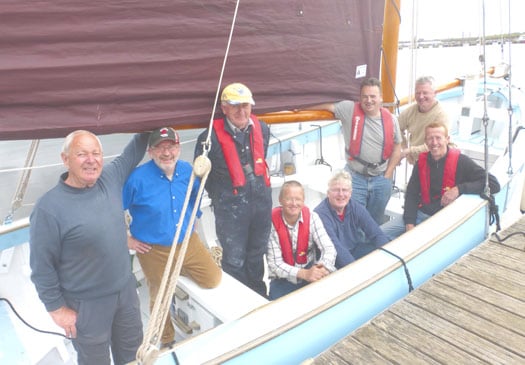
Some of the team at Querrin Sailing who built and sail the Sally O'Keeffe. Seen aboard on launching day at Kilrush are (left to right) Joe Hassett, Criostoir Mac Carthaigh, Michael O'Connell, Stephen Morris, Dixie Collins, Fintan Ryan, John Kennedy and Stephen Courage. Photo: W M Nixon

Steve Morris. Photo: W M Nixon
As for the building team, the trainee boatbuilders ranged in age from 16 to 80. It all became very possible thanks to Steve Morris, a fully-qualified New Zealand boatbuilder who came to Ireland a long time ago while taking a world backpack tour, and somehow stayed. He got involved in the building of the Jeannie Johnston on Tralee Bay in 1986, and for several years now he has lived near the shores of Poulnasherry Bay, and is a pillar of the maritime scene locally and nationally.
Steve served a full five year apprenticeship in boat-building in Auckland, so the community boat-builders of Querrin have had guidance and teaching of gold standard. In fact, thanks to Steve's input and the enormous goodwill and enthusiasm which the project engendered, it's doubtful if she could have been better built anywhere else in Ireland, while this video of him demonstrating caulking skills shows the standards to which they worked.
The ethos underlying the project has been eloquently articulated by Richard "Dixie" Collins, another of the key movers and shakers in Querrin Sailing:
"This is very much a community project from Loop Head peninsula. A keen, salty group who are sharing skills and enthusiasm for getting out on the ocean, to a place with a big sky and lots going on. There is training in seafaring skills for people who have never been out in a boat, and we provide trips to islands, and old piers which were built for boats like this in another time.
Our logo is taken from a gravestone in Scattery Island church of a boat-builder by the name of O'Mahony in 1832. In this small rural part of the western seaboard, we have built a sailing boat which we can maintain ourselves, and we offer sailing opportunities for everyone in the area for a five euro contribution to the club. An important outcome is the capacity building with new relationships, generational sharing of learning and having a right good time ourselves. It strengthens our sense of community, and is a shared credit to the collective efforts of everyone."
Despite the robust hull's obvious sailing power, Sally O'Keeffe needs only one hand on the tiller.
As the Sally O'Keeffe was going to be kept undecked with her hull limited to 25ft overall, for safety reasons they had to ask Myles Stapleton to give her quite high freeboard. It says everything about his skills as a creator of good-looking boats that despite the high freeboard – which has proven a Godsend in both the Estuary and on some remarkable and swift coastal passages on the open Atlantic north to Galway and south to Baltimore – the Sally O'Keeffe has a tremendously vigorous style to her appearance. It lifts the spirits just to see the sweep of her sheer and the elegant way in which the transom stern is incorporated in a sweet yet powerful run aft.
In 2013 she sailed forth more than seventy times, and while the highlights were the voyages to Galway and Baltimore, the essence of her popularity is the shorter jaunts within the Estuary, captured very effectively on this brief video by John Collins taken aboard after overnighting with a camp on Canon Island.
Despite a tiller of only average length, she is easily steered – in fact, "finger-tip control" is the theme of much of her sailing. As for her speed, it has pleasantly surprised everyone involved, and the visit to Baltimore found the little 25-footer from the Shannon pacing with or even over-taking the 33ft mackerel yawls from West Cork.
The Baltimore Wooden Boat Festival (this year's is from 23rd-25th May) is the gathering of the crème de la crème of Ireland's wooden boatbuilders. The very fact that they can be up and running so early in the season is proof they're the tops, but as the Baltimore maritime calendar is so full of events, this is when the timber tribe has to take to the seas, even if many older wooden boats elsewhere in Ireland seldom put a toe out until June.

At the Baltimore Wooden Boat Festival 2013, Sally O'Keeffe found herself pacing with the larger 33ft West Cork mackerel yawl

Baltimore Wooden Boat Festival gathers the crème de la crème of the traditional and classic boat-building brotherhood. This is Rui Ferreira of Ballydehob sailing the Castlehaven Ette Class dinghy which he built, with Sally O'Keeffe in the background making her Baltimore Debut
Meanwhile, nearer home, Querrin Regatta is today. That's right, Saturday May 10th. Unfortunately the weather prospects aren't great, with the jet stream squatting over Ireland like some vast demented dragon. But at least the Sally O'Keeffe is in proper order, as she demonstrated during some heavy weather sailing in the Estuary on Bank Holiday Monday. And the famous West Clare racing currachs are up for it too – last Sunday we saw one of the renowned Doonbeg racing currachs in intensive training off their little port, where the inner reaches now have a handy pontoon in a pool in the river.
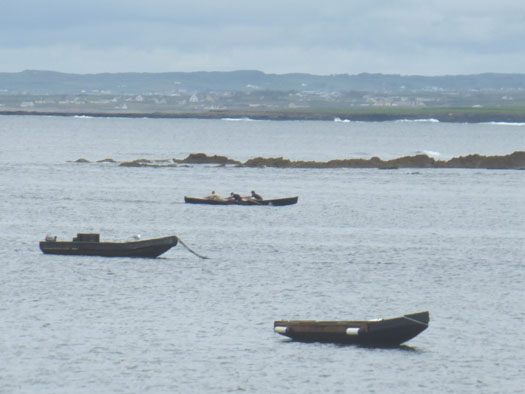
The western way. Racing currach at Doonbeg in training on Sunday morning. Photo: W M Nixon
One local boat which definitely won't be at today's Querrin Regatta is the reason we ended up in Kilrush in the first place. This is Steve Morris's own special pet, and it was Kim Roberts of Askeaton who suggested that this was worth seeing. It certainly is. He has taken a classic Harrison Butler Khamseen design, which is remarkably like an anticipation of Lyle Hess designs like Fred Schotman's Raven from the Netherlands which was in Dublin Bay last year, and is creating his dreamship at home.
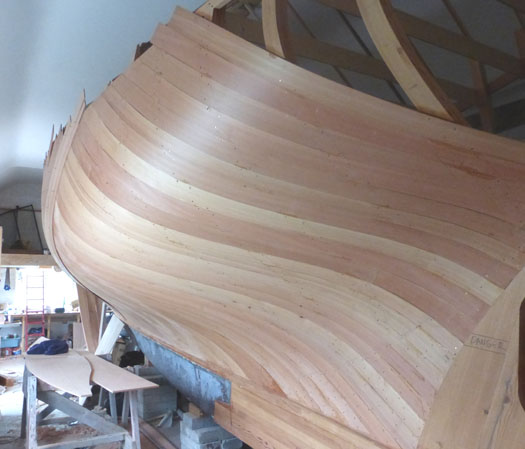
The port side of Steve Morris's 31ft Harrison Butler design looking forward, with the rich texture of the Alpine larch glowing through. Photo: W. M. Nixon
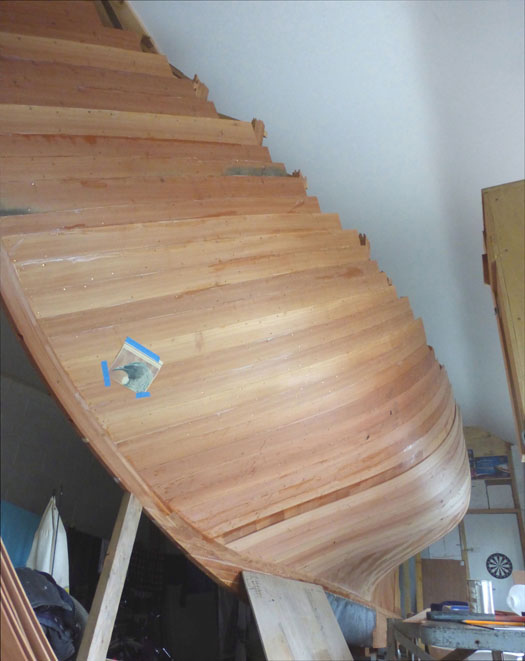
Don't try this at home.....Steve Morris has managed to fit this 31ft hull into the garage beside his house. Photo: W M Nixon
Steve is building this honey of a boat in multi-skin, using dark dense Alpine larch, the leftovers of a consignment of timber which was brought in from Austria for the building of Jeanie Johnston. The man works so neatly that he has managed to fit the entire project into the admittedly spacious garage beside his house near Moyasta, and the workshop is one of those spiritually-enhancing places which are a balm for the soul.
Particularly impressive is the perfectly-shaped lead ballast keel which fits so well into Harrison Butler's flowing lines. And it's typical of this job too. For when I asked him who made the form and cast the keel for him, he was surprised by the question, as the answer simply is: "I did it myself, right here on site".
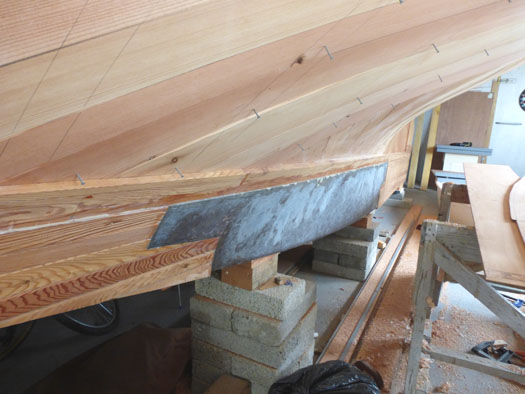
"No problem". The lead ballast keel was cast on site. Photo: W M Nixon
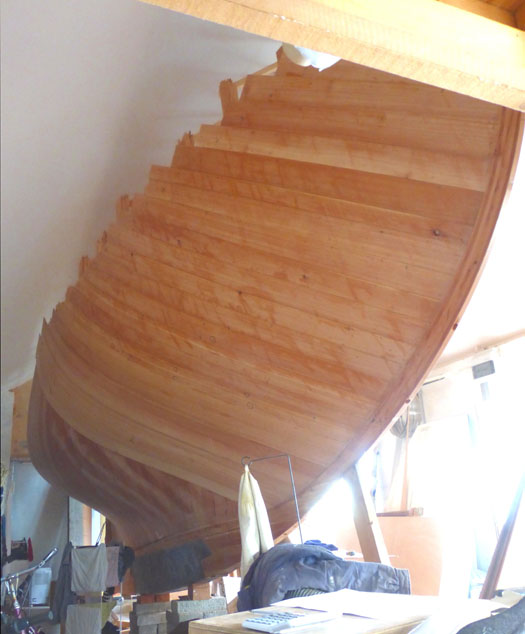
Even with quite a large garage, it's very difficult to get a photo showing all of a 31ft boat. Starboard side looking aft. Photo: W M Nixon
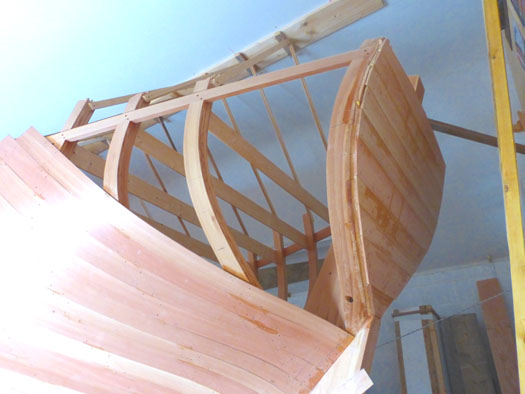
Although the Metacentric Shelf theory of hull design to which Harrison Butler subscribed has been large disproved, he still produced hulls of balanced performance with transom sterns which didn't drag half the ocean after them. Photo: W M Nixon

A dartboard is an essential in any boatbuilding shed. You need something to keep you well away from the job while glue is setting. Photo: W M Nixon
Using "leftover" timber for boat-building projects is an appropriate theme as we emerge from recessionary times. After John Kearon and his team had made such a fine job of conserving Asgard, there were bits and pieces of well-seasoned leftover wood, and they provided enough timber for Pat Murphy and his group of support volunteers to put in train the building of a replica of Asgard's original 1905 10ft dinghy, designed by Colin Archer himself.
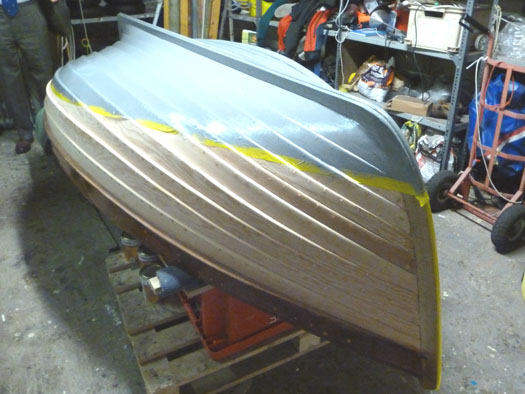
Asgard's dinghy starts to get the finishing treatment. Photo: W M Nixon
It was Fingal boatbuilder Larry Archer (absolutely no relation to the great designer, we're told) who put the little boat together. Like Myles Stapleton when he was tidying up the original drawings of Asgard's lines for a book two decades ago, Larry was very impressed with the way Archer's mind worked, as he designed the transom of the little boat to sit clear of the water when carrying a normal load, thus enabling her to slip easily along without leaving a wake like the inside of a washing machine.

Pat Murphy with Asgard's dinghy. After leading the creation of this little beauty, he understandably has mixed feels about putting her in rugged salt water. Photo: W M Nixon
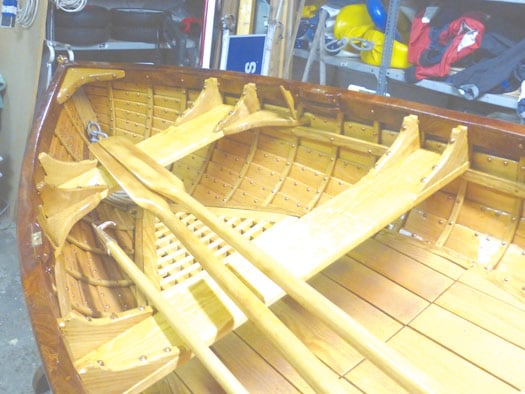
Classic construction and finish detail up forward. Photo: W M Nixon

The interior in the stern – for a ten footer, she is remarkably detailed, particularly where the required twist is put into the planking to maintain a sweet run aft. Photo: W M Nixon
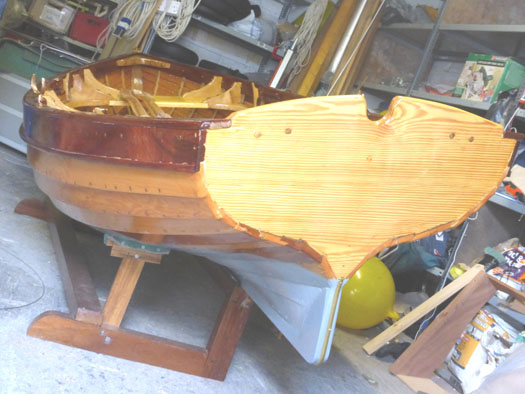
With a clever design to keep the transom clear of the water when the boat is carrying a normal load, Colin Archer created an easily driven yet workmanlike hull. Photo: W M Nixon
It's a remarkable bit of boat design, but with the dry timber it was the very devil to build in the necessary twists.. However, it was done in the end, and the new boat emerged in all her glory, exquisitely finished in classic varnishwork by Pat Murphy and George Elliott, with Neville Maguire making an impressive job of restoring an old set of oars to match the style.
Public debut – Agard's dinghy at Howth Prawn Festival. Photo: Pat Murphy
Asgard's dinghy made her public debut at the Howth Prawn Festival a fortnight ago, and was a star of the show. But the trouble is that when you get a boat finished to this standard, the very thought of putting her into rugged salt water is not appealing. Pat and his team accept the fact that the Asgard dinghy will have to go afloat for the Erskine & Molly Childers Asgard Centenary at Howth on Sunday July 27th. But for now they're much happier just admiring this gem as she shines in the shed, safe from the sea. And who can blame them?




























